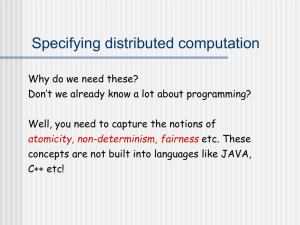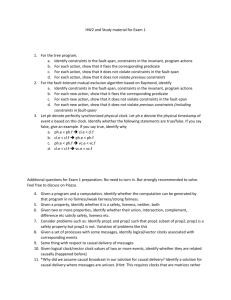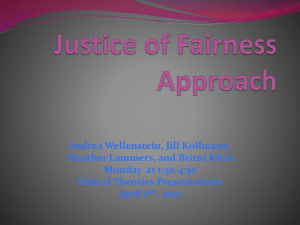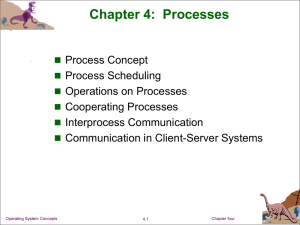Correctness criteria and Proof techniques
advertisement
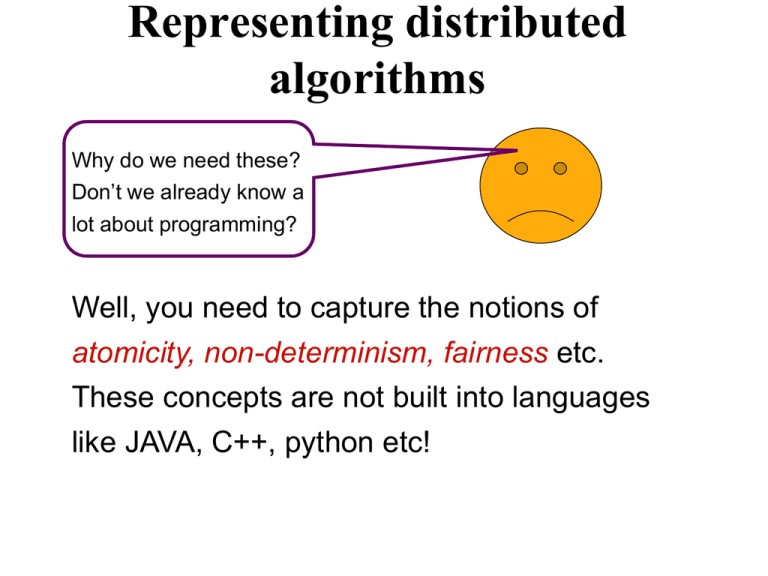
Representing distributed
algorithms
Why do we need these?
Don’t we already know a
lot about programming?
Well, you need to capture the notions of
atomicity, non-determinism, fairness etc.
These concepts are not built into languages
like JAVA, C++, python etc!
Syntax & semantics:
guarded actions
<guard G> <action A>
is equivalent to
if G then A
(Borrowed from E.W. Dijkstra: A Discipline of Programming)
Syntax & semantics: guarded
actions
• Sequential actions
S0; S1; S2; . . . ; Sn
• Alternative constructs
if . . . . . . . . . . fi
• Repetitive constructs
do . . . . . . . . . od
The specification is useful for
representing abstract algorithms, not
executable codes.
Syntax & semantics
Alternative construct
if
[]
…
[]
fi
G1 S1
G2 S2
Gn Sn
When no guard is true, skip (do nothing). When
multiple guards are true, the choice of the action to
be executed is completely arbitrary.
Syntax & semantics
Repetitive construct
do
[]
.
[]
od
G1 S1
G2 S2
Gn Sn
Keep executing the actions until all guards are false
and the program terminates. When multiple guards
are true, the choice of the action is arbitrary.
Example: graph coloring
1
0
0
There are four processes and two colors
0, 1. The system has to reach a configuration
in which no two neighboring processes have
the same color.
{program for process i}
c[i] = color of process I
1
do
∃j ∈ neighbor(i): c(j) = c(i) → c(i) := 1- c(i)
od
Will the above computation terminate?
Consider another example
program
define
initially
do
x<4
[]
x=3
od
uncertain;
x :
integer;
x=0
x := x + 1
x := 0
Question. Will the program terminate?
(Our goal here is to understand fairness)
The adversary
A distributed computation can be
viewed as a game between the
system and an adversary. The
adversary may come up with feasible
schedules to challenge the system
(and cause “bad things”). A correct
algorithm must be able to prevent
those bad things from happening.
Non-determinism
(Program for a token server - it has a single token}
repeat
if (req1 ∧ token) then give the token to client1
else if (req2 ∧ token) then give the token to client2
else if (req3 ∧ token) then give the token to client3
forever
Now, assume that all three requests are sent simultaneously.
Client 2 or 3 may never get the token! The outcome could
have been different if the server makes a non-deterministic
choice.
Token server
1
2
3
Examples of non-determinism
If there are multiple processes ready to execute actions,
then who will execute the action first is nondeterministic.
Message propagation delays are arbitrary and the order
of message reception is non-deterministic.
Determinism caters to a specific order and is a special
case of non-determinism.
Atomicity (or granularity)
Atomic = all or nothing
Atomic actions = indivisible actions
do red message x:= 0 {red action}
[] blue message x:=7 {blue action}
od
x
Regardless of how nondeterminism is
handled, we would expect that the value of
x will be an arbitrary sequence of 0's and 7's.
Right or wrong?
Atomicity (continued)
do red message x:= 0 {red action}
[] blue message x:=7 {blue action}
od
Let x be a 3-bit integer x2 x1 x0, so
x:=7 means (x2:=1, x1:= 1, x2:=1), and
x:=0 means (x2:=0, x1:= 0, x2:=0)
x
If the assignment is not atomic, then many
interleavings are possible, leading to
any possible value of x between 0 and 7
So, the answer depends on the atomicity of the assignment
Atomicity (continued)
Does hardware guarantee any form
of atomicity? Yes! (examples?)
if x ≠ y x:= y fi
Transactions are atomic by
definition (in spite of process
failures). Also, critical section
codes are atomic.
We will assume that G → A is an
“atomic operation.” Does it make
a difference if it is not so?
x
y
if x ≠ y y:= x fi
Atomicity (continued)
{Program for P}
define b: boolean
initially b = true
do b send msg m to Q
[] ¬ empty(R,P) receive msg;
b := false
od
Suppose it takes 15 seconds to
send the message. After 5 seconds,
P receives a message from R. Will it
stop sending the remainder of the
message?
NO.
R
P
b
Q
Fairness
Defines the choices or restrictions
on the scheduling of actions. No
such restriction implies an
unfair scheduler. For fair
schedulers, the following types of
fairness have received attention:
– Unconditional fairness
– Weak fairness
– Strong fairness
Scheduler / demon /
adversary
Fairness
Program
test
define x : integer
{initial value unknown}
do
[]
[]
od
true
x=0
x=1
x:=0
x:=1
x:=2
An unfair scheduler may never
schedule the second (or the third
actions). So, x may always be
equal to zero.
An unconditionally fair scheduler
will eventually give every
statement a chance to execute
without checking their eligibility.
(Example: process scheduler in
a multiprogrammed OS.)
Weak fairness
• A scheduler is weakly fair,
when it eventually executes
every guarded action whose
guard becomes true, and
remains true thereafter
Program test
define x : integer
{initial value unknown}
do
true x : = 0
[]
x = 0 x : = 1 • A weakly fair scheduler will
eventually execute the
[]
x=1 x:=2
second action, but may
od
never execute the third
action. Why?
Strong fairness
Program
test
define
x : integer
{initial value unknown}
do
true x : = 0
[]
x=0 x:=1
[]
x=1 x:=2
od
A scheduler is strongly fair, when it
eventually executes every guarded
action whose guard is true infinitely
often.
The third statement will be executed
under a strongly fair scheduler. Why?
Study more examples to reinforce these concep
Program correctness
The State-transition model
transition
A global state S ∈ s0 x s1 x … x sm
C
{sk = local state of process k}
action
S0
S1
action
action
S2 …
A
D
E
B
F
G
Each state transition is caused by an
action by an eligible process.
state
H
L
I
Initial
state
J
K
We reason using interleaving
semantics, and assume that concurrent
actions are serialized in an arbitrary order
A sample computation (or behavior) is ABGHIFL
Correctness criteria
• Safety properties
• Bad things never happen
• Liveness properties
• Good things eventually happen
Testing vs. Proof
Testing: Apply inputs and observe if the outputs
satisfy the specifications. Fool proof testing can be
painfully slow, even for small systems. Most testing
are partial.
Proof: Has a mathematical foundation, and is a
complete guarantee. Sometimes not scalable.
Testing vs. Proof
To test this program, you have
to test all possible interleavings.
With n processes p0, p1, … pn-1,
and m steps per process, the
number of interleavings is
(n.m)!
(m!) n
The state explosion problem
p0
p1
p2
p3
step1 step1 step1 step1
step2 step2 step2 step2
step3 step3 step3 step3
Example: Mutual Exclusion
Process 0
do true
Entry protocol
Critical section
Exit protocol
od
Process 1
do true
Entry protocol
Critical section
Exit protocol
od
Safety properties
(1) There is no deadlock
(2) At most one process is in its critical section.
Liveness property
A process trying to enter the CS must eventually succeed.
(This is also called the progress property)
CS
CS
Exercise
program mutex 1
{two process mutual exclusion algorithm: shared memory model}
define busy :shared boolean (initially busy = false}
{process 0}
{process 1}
do true
do true
do busy skip od;
do busy skip od;
busy:= true;
busy:= true;
critical section;
critical section
busy := false;
busy := false
{remaining codes}
{remaining codes}
od
od
Does this mutual exclusion protocol satisfy liveness and safety properties?
Safety invariants
Invariant means: something meaningful should always hold
Example: Total no. of processes in CS ≤ 1 (mutual exclusion problem)
Another safety property is Partial correctness. It implies that
“If the program terminates then the postcondition will hold.”
Consider the following:
do G0 S1 [] G1 S1 [] … [] Gk Sk od
Safety invariant: ¬(G0 ∨ G1 ∨ G2 ∨…∨ Gk) ⇒ postcondition
It does not say if the program will terminate.
(termination is a liveness property)
Total correctness = partial correctness + termination.
Exercise
Starting from the given initial state, devise an algorithm to color the
nodes of the graph using the colors 0 and 1, so that no
two adjacent nodes have the same color.
0
program colorme {for process Pi }
0
p1
p2
p0
p3
1
1
define color c ∈ {0, 1}
Initially colors are arbitrary
do ∃j ∈neighbor(i) : (c[i] = c[j]) → c[i] := 1 - c[i] od
Is the program partially
correct? YES (why?)
Does it terminate? NO (why?)
Liveness properties
Eventuality is tricky. There is no need to guarantee when
the desired thing will happen, as long as it happens..
Some examples
The message will eventually reach the receiver.
The process will eventually enter its critical section.
The faulty process will be eventually be diagnosed
Fairness (if an action will eventually be scheduled)
The program will eventually terminate.
The criminal will eventually be caught.
Absence of liveness cannot be determined from finite prefix
of the computation
Proving safety
define
c1, c2 : channel; {init c1 = c2 = null}
r, t : integer; {init r = 5, t = 5}
{program for T}
1
do t > 0 → send msg along c1; t := t -1
2
[] ¬empty (c2) → rcv msg from c2; t := t + 1
od
{program for R}
3
do ¬empty (c1) → rcv msg from c1; r := r+1
4
[]
r>0
→ send msg along c2; r := r-1
od
the safety property P:
P ≡ n1 + n2 ≤ 10
We want to prove
n1= # of messages in c1
n2= # of messages in c2
c1
t T
R
r
c2
transmitter
receiver
Proving safety
n1, n2 = # of messages in c1and c2 respectively.
We will establish the following invariant:
c1
I ≡ (t ≥ 0) ∧ (r ≥ 0) ∧ (n1 + t + n2 + r = 10)
(I ⇒ P). Check if I holds after every action.
{program for T}
1
do t > 0 → send msg along c1; t := t -1
2
[] ¬empty (c2) → rcv msg from c2; t := t+1
od
{program for R}
3
do ¬empty (c1) → rcv msg from c1; r := r+1
4
[]
r>0
→ send msg along c2; r := r-1
od
t=4
T
R
r=1
c2
Use the method of induction
Show that I initially holds, and
holds after each action.
Proving liveness
Global state
Global state
S1→ S2 → S3 → S4
↓ f ↓f
↓f ↓f
w1 w2 w3 w4
o w1, w2, w3, w4 ∈ WF
o WF is a well-founded set whose
elements can be ordered by » and
there is a smallest element
f is called a variant function
If there is no infinite chain like
w1 » w2 » w3 » w4 .., i.e.
f(si) » f(si+1) » f(si+2) ..
then the computation will
definitely terminate!
Example?
Proof of liveness: an example
0
Clock phase synchronization
1
System of n clocks ticking at the same rate.
Each clock is 3-valued, i,e it ticks as 0, 1, 2, 0, 1, 2…
2
3
n-1
A failure may arbitrarily alter the clock phases.
The clocks need to return to the same phase. .
Proof of liveness: an example
∀k: c[k] ∈ {0,1,2}
Clock phase synchronization
{Program for each clock}
(c[k] = phase of clock k, initially arbitrary)
0
do ∃j: j∈ N(i) :: c[j] = c[i] +1 mod 3
c[i] := c[i] + 2 mod 3
→
[] ∀j: j ∈ N(i) :: c[j] ≠ c[i] +1 mod 3
c[i] := c[i] + 1 mod 3
→
od
Show that eventually all clocks will return
to the same phase (convergence), and
continue to be in the same phase (closure)
1
2
3
n-1
Proof of convergence
0
1
2
0
2
2
2
0
1
1
0
1
1
2
2
2
n-1
2
Understand the game of arrows
2
Let D = d[0] + d[1] + d[2] + … + d[n-1]
d[i] = 0 if no arrow points towards clock i;
= i + 1 if a ← points towards clock i;
= n - i if a → points towards clock i;
= 1 if both → and ← point towards clock i.
By definition, D
≥ 0.
Also, D decreases after every step in the
system. So the number of arrows must
reduce to 0.
